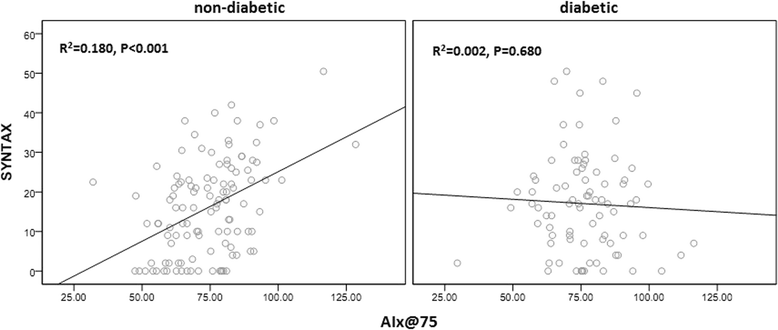Type 2 diabetes compromises the value of non-invasively measured augmentation index in predicting the severity of coronary artery disease: a hospital-based observational study
- PMID: 27832749
- PMCID: PMC5105255
- DOI: 10.1186/s12872-016-0392-2
Type 2 diabetes compromises the value of non-invasively measured augmentation index in predicting the severity of coronary artery disease: a hospital-based observational study
Abstract
Background: Central hemodynamic indices have been demonstrated to correlate with coronary artery disease (CAD). However, in the context of type 2 diabetes mellitus (DM), this correlation has not been fully illustrated. Therefore, this study was employed to investigate the impact of DM on the correlation between aortic augmentation index and the severity of coronary artery disease.
Methods: In this study, we analyzed 197 patients who underwent coronary angiography at Anzhen Hospital from September 2015 to January 2016. Central hemodynamics were non-invasively measured with BPro® device (Health STATS, Singapore). The severity of CAD was defined according to SYNTAX scores. Type 2 diabetes was defined according to ADA guidelines. AIx@75 was defined as AIx normalized to a heart rate of 75 bpm. Receiver operating characteristics (ROC) determined the optimal cut-off value of AIx@75 to predict moderate to severe CAD. Multivariate logistic regression analysis evaluated the correlation between central hemodynamic parameters and CAD severity.
Results: Eighty-four (42.6 %) of the studied subjects were diabetic patients. Our findings were that (1) AIx@75 was significantly correlated with SYNTAX. (ROC analyzed AUC: 0.638, 95 % CI 0.555-0.721, p < 0.05). The cut-off value of AIx@75 to predict moderate-to-severe CAD as SYNTAX score more than 22 was 71.45. (2) In non-diabetic patients, correlation analysis revealed that AIx@75, augmentation pressure and peak relative time were significantly correlated with CAD severity (p < 0.05). After adjustment, AIx@75 remained as the only independent predictor of moderate-to-severe CAD (odds ratio 1.099, 95 % CI 1.028-1.176, p < 0.05). (3) In diabetic patients, the correlation between central hemodynamic parameters and the severity of CAD did not exist.
Conclusions: Aortic augmentation index was significantly related to the severity of CAD and was an independent predictor of severe CAD. However, clinical practitioners should note that its value in DM populations was compromised.
Keywords: Augmentation index; Coronary artery disease; SYNTAX score; Type 2 diabetes mellitus.
Figures
Similar articles
-
Central pulse pressure amplification is associated with more extensive and severe coronary artery disease.Scand Cardiovasc J. 2014 Jun;48(3):167-75. doi: 10.3109/14017431.2014.898083. Epub 2014 Mar 31. Scand Cardiovasc J. 2014. PMID: 24568590 Clinical Trial.
-
Non-invasively measured aortic wave reflection and pulse pressure amplification are related to the severity of coronary artery disease.J Cardiol. 2013 Aug;62(2):131-7. doi: 10.1016/j.jjcc.2013.03.014. Epub 2013 May 31. J Cardiol. 2013. PMID: 23731925
-
Correlation between the Finnish Diabetes risk Score and the severity of coronary artery disease.Vojnosanit Pregl. 2014 May;71(5):474-80. Vojnosanit Pregl. 2014. PMID: 26137713
-
Screening and Risk Assessment of Coronary Artery Disease in Patients With Type 2 Diabetes: An Updated Review.In Vivo. 2019 Jul-Aug;33(4):1039-1049. doi: 10.21873/invivo.11572. In Vivo. 2019. PMID: 31280191 Free PMC article. Review.
-
Risk Stratification for Asymptomatic Coronary Artery Disease in patients with Type II Diabetes Mellitus.J Assoc Physicians India. 2021 Nov;69(11):11-12. J Assoc Physicians India. 2021. PMID: 34781616 Review.
References
Publication types
MeSH terms
LinkOut - more resources
Full Text Sources
Other Literature Sources
Medical
Research Materials
Miscellaneous



